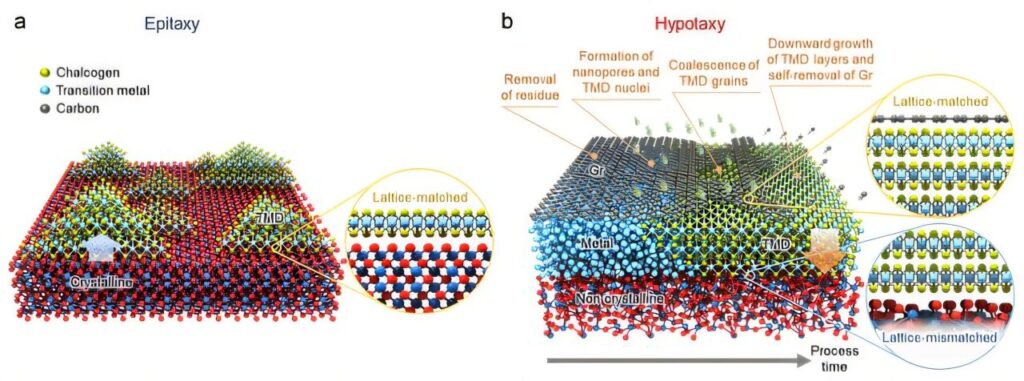A research team has successfully developed a new synthesis technology for 2D semiconductors. This technique enables the direct growth of wafer-scale single-crystal 2D semiconductors on various substrates. The research is published in Nature.
With the advancement of artificial intelligence (AI) technology, the demand for enhanced semiconductor performance has increased, along with active research on reducing power consumption in semiconductor devices. As a result, new semiconductor materials to replace conventional silicon are gaining attention.
Among them, 2D materials such as transition metal dichalcogenides (TMDs) have been highlighted as next-generation semiconductors due to their thin structure and excellent electrical properties. However, there is currently a lack of mass production technology to synthesize them in high quality and utilize them industrially.
The most promising synthesis method to date, chemical vapor deposition (CVD), suffers from issues such as degradation of electrical properties and the necessity of transferring grown TMDs to different substrates, adding extra complexity to the process. Additionally, the “epitaxy” method, which grows TMDs on highly crystalline substrates, also requires a transfer process and is limited to specific substrates.
Consequently, the development of advanced 3D integration technology based on high-quality TMDs has emerged as a crucial challenge in the modern semiconductor industry, further emphasizing the urgent need for a novel TMD synthesis method.
To address this issue, the research team developed a completely new growth method. They introduced an approach that leverages 2D materials—such as graphene and hexagonal boron nitride—as templates, guiding TMD crystal alignment to enable the synthesis of perfectly single-crystalline TMD films on any substrate. This technique, named “hypotaxy,” was developed for the first time in the world. The name “hypotaxy” was derived by combining “hypo” (meaning “downward”) and “taxy” (meaning “arrangement”), reflecting the downward growth characteristic of the synthesized films.

This technology holds significant industrial potential as it allows the growth of single-crystal TMDs at a low temperature (400°C), making it compatible with existing semiconductor manufacturing processes. Additionally, the graphene template naturally disappears without requiring a post-removal process, and the thickness of the metal film can be precisely controlled to regulate the number of TMD layers. These distinguishing features set hypotaxy apart from existing methods.
Furthermore, semiconductor devices fabricated using TMDs synthesized through hypotaxy demonstrated high charge carrier mobility and excellent device uniformity, indicating that hypotaxy has great potential to contribute to the development of high-performance, high-integration 2D semiconductor devices and the commercialization of next-generation 2D semiconductors.
Beyond its application in 2D semiconductor growth, hypotaxy is being recognized as an innovative technique applicable to the synthesis of all crystalline thin-film materials. By not only overcoming the limitations of traditional semiconductor fabrication methods but also enabling precise control over crystal orientation and structure through templating, this approach presents a groundbreaking method that has never been proposed before.

Professor Gwan-Hyoung Lee, who led the research, emphasized the significance of the study, stating, “The hypotaxy technique that we have developed overcomes the limitations of epitaxy, a concept first proposed in the 1930s and a fundamental pillar of modern electronic device development. Since hypotaxy enables 3D integration, which is essential for next-generation AI semiconductors, I expect it will establish itself as a revolutionary approach in materials engineering.”
Donghoon Moon, the first author of the paper, reflected on the research process, saying, “The greatest challenge was breaking away from the conventional perception of epitaxy, which has been the standard for synthesizing various high-quality materials. Just as hypotaxy emerged from a counterintuitive perspective on epitaxy, I hope this achievement serves as a catalyst for groundbreaking research in areas such as new material development and the synthesis of novel lattice structures.”


